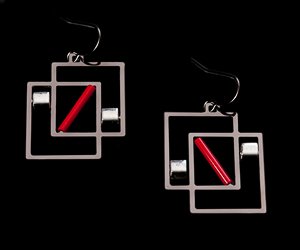Tel : (+33) 4 94 63 18 08
9am - 6pm from Monday to Sunday
Paul Klee
Biography of Paul Klee

Paul Klee
Paul Klee was born on December 18, 1879, in Switzerland. After several years perfecting his painting skills, he discovered the works of Van Gogh and then those of Cézanne, the "master par excellence".
In 1911, he met the artists of the "Blaue Reiter".
The following three years marked a crucial turning point in Klee's work and his approach to painting, but he was mobilized from 1916 to 1918.
His reputation grew after the war. Having become a professor at the Bauhaus, alongside his friend Kandinsky, he participated in the first surrealist exhibition in Paris in 1925. He left the Bauhaus in 1931 for the Düsseldorf Academy. Two years later, he was dismissed under pressure from the Nazis.
Devastated, Paul Klee took refuge in his hometown, Berne. However, his health deteriorated rapidly. In 1937, Braque and Picasso traveled to Berne to visit him. Klee's works belonging to German public collections were confiscated; seventeen of them were featured in the "degenerate art" exhibition in Munich.
On June 29, 1940, Paul Klee died from paralysis of the heart muscle.
(c) Natacha PELLETIER for PASSION ESTAMPES

Paul Klee
Paul Klee was born on December 18, 1879, in Switzerland. After several years perfecting his painting skills, he discovered the works of Van Gogh and then those of Cézanne, the "master par excellence".
In 1911, he met the artists of the "Blaue Reiter".
The following three years marked a crucial turning point in Klee's work and his approach to painting, but he was mobilized from 1916 to 1918.
His reputation grew after the war. Having become a professor at the Bauhaus, alongside his friend Kandinsky, he participated in the first surrealist exhibition in Paris in 1925. He left the Bauhaus in 1931 for the Düsseldorf Academy. Two years later, he was dismissed under pressure from the Nazis.
Devastated, Paul Klee took refuge in his hometown, Berne. However, his health deteriorated rapidly. In 1937, Braque and Picasso traveled to Berne to visit him. Klee's works belonging to German public collections were confiscated; seventeen of them were featured in the "degenerate art" exhibition in Munich.
On June 29, 1940, Paul Klee died from paralysis of the heart muscle.
(c) Natacha PELLETIER for PASSION ESTAMPES

Paul Klee
Paul Klee was born on December 18, 1879, in Switzerland. After several years perfecting his painting skills, he discovered the works of Van Gogh and then those of Cézanne, the "master par excellence".
In 1911, he met the artists of the "Blaue Reiter".
The following three years marked a crucial turning point in Klee's work and his approach to painting, but he was mobilized from 1916 to 1918.
His reputation grew after the war. Having become a professor at the Bauhaus, alongside his friend Kandinsky, he participated in the first surrealist exhibition in Paris in 1925. He left the Bauhaus in 1931 for the Düsseldorf Academy. Two years later, he was dismissed under pressure from the Nazis.
Devastated, Paul Klee took refuge in his hometown, Berne. However, his health deteriorated rapidly. In 1937, Braque and Picasso traveled to Berne to visit him. Klee's works belonging to German public collections were confiscated; seventeen of them were featured in the "degenerate art" exhibition in Munich.
On June 29, 1940, Paul Klee died from paralysis of the heart muscle.
(c) Natacha PELLETIER for PASSION ESTAMPES

Paul Klee
Paul Klee was born on December 18, 1879, in Switzerland. After several years perfecting his painting skills, he discovered the works of Van Gogh and then those of Cézanne, the "master par excellence".
In 1911, he met the artists of the "Blaue Reiter".
The following three years marked a crucial turning point in Klee's work and his approach to painting, but he was mobilized from 1916 to 1918.
His reputation grew after the war. Having become a professor at the Bauhaus, alongside his friend Kandinsky, he participated in the first surrealist exhibition in Paris in 1925. He left the Bauhaus in 1931 for the Düsseldorf Academy. Two years later, he was dismissed under pressure from the Nazis.
Devastated, Paul Klee took refuge in his hometown, Berne. However, his health deteriorated rapidly. In 1937, Braque and Picasso traveled to Berne to visit him. Klee's works belonging to German public collections were confiscated; seventeen of them were featured in the "degenerate art" exhibition in Munich.
On June 29, 1940, Paul Klee died from paralysis of the heart muscle.
(c) Natacha PELLETIER for PASSION ESTAMPES

Paul Klee
Paul Klee was born on December 18, 1879, in Switzerland. After several years perfecting his painting skills, he discovered the works of Van Gogh and then those of Cézanne, the "master par excellence".
In 1911, he met the artists of the "Blaue Reiter".
The following three years marked a crucial turning point in Klee's work and his approach to painting, but he was mobilized from 1916 to 1918.
His reputation grew after the war. Having become a professor at the Bauhaus, alongside his friend Kandinsky, he participated in the first surrealist exhibition in Paris in 1925. He left the Bauhaus in 1931 for the Düsseldorf Academy. Two years later, he was dismissed under pressure from the Nazis.
Devastated, Paul Klee took refuge in his hometown, Berne. However, his health deteriorated rapidly. In 1937, Braque and Picasso traveled to Berne to visit him. Klee's works belonging to German public collections were confiscated; seventeen of them were featured in the "degenerate art" exhibition in Munich.
On June 29, 1940, Paul Klee died from paralysis of the heart muscle.
(c) Natacha PELLETIER for PASSION ESTAMPES






































































